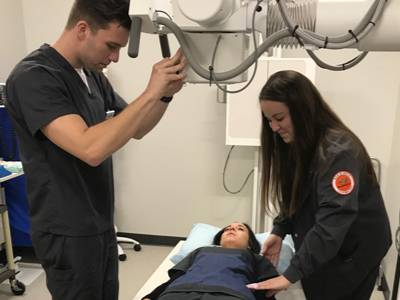Radiologic Technology

About the Radiologic Technology program
Benefits of an OSU-OKC Radiologic Technology Degree:
- As part of the requirements for the American Registry of Radiologic Technologists (ARRT) certification process, candidates must complete an ARRT verified educational program and earn an academic degree (associate degree or higher). OSU-OKC’s Radiologic Technology program is an ARRT verified educational program and offers an Associate of Applied Science academic degree, which meets these requirements.
- OSU-OKC’s Radiologic Technology program is accredited through OSU-OKC’s Higher Learning Commission (HLC) Institutional Accreditation, which is an ARRT recognized accreditation agency. Upon program completion, graduates are eligible for national board exams through the ARRT.
- Students will participate in instructor-led lab sessions using state-of-the-art Direct Digital radiography and PACS systems.
- Students are exposed to a wide variety of procedures in the clinical setting to allow them to achieve program competency requirements, with a 1:1 student to radiography clinical staff ratio at each clinical site.
Admission to the Radiologic technology program is based on a points system. One class is admitted to the program every academic year. Up to 22 students are admitted each year with the applicant pool varying from 100 to 200 applications. The actual accepted number is commensurate with the number of clinical rotation sites available to offer the students.
The following factors are considered as part of the final selection into the program:
- Background Check: Must be completed through the designated vendor only. Admission may be denied to applicants with a criminal history or to those who submit false information.
- GPA Requirement: A minimum cumulative GPA of 2.5 from all previous college-level coursework is required.
- TEAS-ATI Test: A current Pre-Admission TEAS (Test of Essential Academic Skills) score is required.
- Prerequisite Coursework: Completion of all required prerequisite or equivalent courses with a grade of C or higher.
- Recommendation and Personal Achievement letters
- Vaccination/Immunization Records: Proof of pre-clinical immunizations as outlined in the Student Handbook.
- Drug Screening: A negative 10-panel urine drug screen conducted through the designated vendor only.
- Technical Standards: Applicants must meet the program’s established technical standards.
- Additional Pre-Clinical Documentation required:
- Campus-Wide Student ID (CWID)
- American Heart Association BLS CPR certification
- Valid driver’s license and REAL ID
- Social Security card
- Current USCIS or U.S. Department of State documentation (if applicable)
- Health insurance card
- Vehicle information (make, model, and license plate number)
- Completed orientation and handbook acknowledgment forms
- Completed Human Resources forms
- Any additional onboarding documentation required by clinical sites
JOB FACT FILE
Radiologic Technologists and Technicians are among Oklahoma’s Top 100 Critical Occupations with an average of 244 annual openings and median annual earnings of $60,049.60 with an associate degree. Top 100 Critical Occupations - Oklahoma Works - Oklahoma Works
According to the Bureau of Labor and Statistics, national employment of radiologic
technologists is projected to grow 6 percent from 2021 to 2031, about as fast as the
average for all occupations. About 16,600 openings for radiologic and MRI technologists
are projected each year, on average, over the decade.
https://www.bls.gov/ooh/healthcare/radiologic-technologists.htm#tab-6
Computer Literacy Requirement
Students enrolled in the program will be expected to use the computer for generating reports, testing, computer-assisted instruction and electronic searches. The cardiovascular technology curriculum at OSU-Oklahoma City is computer intensive. Graduation from the program allows the student to meet the computer literacy requirement. An introductory computer course is recommended for students lacking computer experience and/or skills.